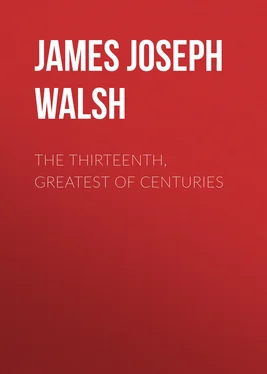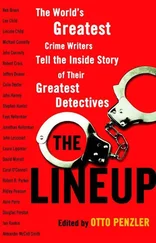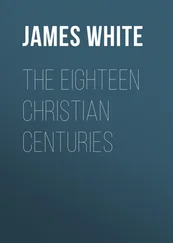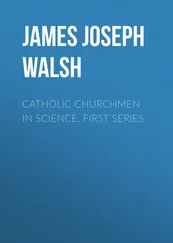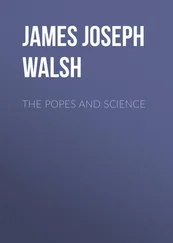James Walsh - The Thirteenth, Greatest of Centuries
Здесь есть возможность читать онлайн «James Walsh - The Thirteenth, Greatest of Centuries» — ознакомительный отрывок электронной книги совершенно бесплатно, а после прочтения отрывка купить полную версию. В некоторых случаях можно слушать аудио, скачать через торрент в формате fb2 и присутствует краткое содержание. Жанр: foreign_prose, История, foreign_edu, foreign_antique, на английском языке. Описание произведения, (предисловие) а так же отзывы посетителей доступны на портале библиотеки ЛибКат.
- Название:The Thirteenth, Greatest of Centuries
- Автор:
- Жанр:
- Год:неизвестен
- ISBN:нет данных
- Рейтинг книги:3 / 5. Голосов: 1
-
Избранное:Добавить в избранное
- Отзывы:
-
Ваша оценка:
- 60
- 1
- 2
- 3
- 4
- 5
The Thirteenth, Greatest of Centuries: краткое содержание, описание и аннотация
Предлагаем к чтению аннотацию, описание, краткое содержание или предисловие (зависит от того, что написал сам автор книги «The Thirteenth, Greatest of Centuries»). Если вы не нашли необходимую информацию о книге — напишите в комментариях, мы постараемся отыскать её.
The Thirteenth, Greatest of Centuries — читать онлайн ознакомительный отрывок
Ниже представлен текст книги, разбитый по страницам. Система сохранения места последней прочитанной страницы, позволяет с удобством читать онлайн бесплатно книгу «The Thirteenth, Greatest of Centuries», без необходимости каждый раз заново искать на чём Вы остановились. Поставьте закладку, и сможете в любой момент перейти на страницу, на которой закончили чтение.
Интервал:
Закладка:
"Yet there has always in generous souls who have some tincture of philosophy, subsisted a curious kind of sympathy and yearning over the work of these generations of mainly disinterested scholars, who, whatever they were, were thorough, and whatever they could not do, could think. And there, have even, in these latter days, been some graceless ones who have asked whether the Science of the nineteenth century, after an equal interval, will be of any more positive value—whether it will not have even less comparative interest than that which appertains to the Scholasticism of the Thirteenth."
In the light of this it has seemed well to try to show in terms of present-day science some of the important reflections with regard to such problems of natural history, as magnetism, the composition of matter, and the relation of things physical to one another, which we now include under the name science, some of the thoughts that these scholars of the Thirteenth Century were thinking and were developing for the benefit of the enthusiastic students who flocked to the universities. We will find in such a review though it must necessarily be brief many more anticipations of modern science than would be thought possible.
To take the example for the moment of magnetism which is usually considered to be a subject entirely of modern attention, a good idea of the intense interest of this century in things scientific, can be obtained from the following short paragraph in which Brother Potamian in his sketch of Petrus Peregrinus, condenses the references to magnetic phenomena that are found in the literature of the time. Most of the writers he mentions were not scientists in the ordinary sense of the word but were literary men, and the fact that these references occur shows very clearly that there must have been wide-spread interest in such scientific phenomena, since they had attracted the attention of literary writers, who would not have spoken of them doubtless, but that they knew that in this they would be satisfying as well as exciting public interest.
"Abbot Neckam, the Augustinian (1157-1217), distinguished between the properties of the two ends of the lodestone, and gives in his De Utensilibus, what is perhaps the earliest reference to the mariner's compass that we have. Albertus Magnus, the Dominican (1193-1280), in his treatise De Mineralibus, enumerates different kinds of natural magnets and states some of the properties commonly attributed to them; the minstrel, Guyot de Provins, in a famous satirical poem, written about 1208, refers to the directive quality of the lodestone and its use in navigation, as do also Cardinal de Vitry in his Historia Orientialis (1215-1220), Brunetto Latini, poet, orator and philosopher (the teacher of Dante), in his Tresor des Sciences, a veritable library, written in Paris in 1260; Raymond Lully, the enlightened Doctor, in his treatise, De Contemplatione, begun in 1272, and Guido Guinicelli, the poet-priest of Bologna, who died in 1276." 4 4 The letter of Petrus Peregrinus on the Magnet, A. D. 1269, translated by Bro. Arnold, M. Sc., with an Introductory Note by Bro. Potamian, N. Y., 1904.
The metaphysics of the medieval universities have come in for quite as much animadversion, not to say ridicule, as the dialectics. None of its departments is spared in the condemnation, though most fun is made of the gropings of the medieval mind after truth in the physical sciences. The cosmology, the science of matter as it appealed to the medieval mind, is usually considered to have been so entirely speculative as to deserve no further attention. We have presumably, learned so much by experimental demonstration and original observation in the physical sciences, that any thinking of the medieval mind along these lines may, in the opinion of those who know nothing of what they speak, be set aside as preposterous, or at best nugatory. It will surely be a source of surprise, then, to find that in the consideration of the composition of matter and of the problem of the forces connected with it, the minds of the medieval schoolmen were occupied with just the same questions that have been most interesting to the Nineteenth Century and that curiously enough the conclusions they reached, though by very different methods of investigation, were almost exactly the same as those to which modern physical scientists have attained by their refined methods of investigation.
One or two examples will suffice, I think, to show very clearly that the students of the Thirteenth Century had presented to them practically the same problems with regard to matter, its origin and composition, as occupy the students of the present generation. For instance Thomas Aquinas usually known as St. Thomas, in a series of lectures given at the University of Paris toward the end of the third quarter of the Thirteenth Century, stated as the most important conclusion with regard to matter, that "Nihil omnino in nihilum redigetur ,"' "Nothing at all will ever be reduced to nothingness." By this it was very evident from the context that he meant that matter would never be annihilated and could never be destroyed. It might be changed in various ways but it could never go back into the nothingness from which it had been taken by the creative act. Annihilation was pronounced as not being a part of the scheme of things as far as the human mind could hope to fathom its meaning.
In this sentence, then, Thomas of Aquin was proclaiming the doctrine of the indestructibility of matter. It was not until well on in the nineteenth century that the chemists and physicists of modern times realized the truth of this great principle. The chemists had seen matter change its form in many ways, had seen it disappear apparently in the smoke of fire or evaporate under the influence of heat, but investigation proved that if care were taken in the collection of the gases that came off under these circumstances, of the ashes of combustion and of the residue of evaporation, all the original material that had been contained in the supposedly disappearing substance could be recovered or at least completely accounted for. The physicists on their part had realized this same truth and finally there came the definite enunciation of the absolute indestructibility of matter. St. Thomas' conclusion "Nothing at all will ever be reduced to nothingness" had anticipated this doctrine by nearly seven centuries. What happened in the Nineteenth Century was that there came an experimental demonstration of the truth of the principle. The principle itself, however, had been reached long before by the human mind by speculative processes quite as inerrable in their way as the more modern method of investigation.
When St. Thomas used the aphorism "Nothing at all will ever be reduced to nothingness" there was another signification that he attached to the words quite as clearly as that by which they expressed the indestructibility of matter. For him Nihil or nothing meant neither matter nor form , that is, neither the material substance nor the energy which is contained in it. He meant then, that no energy would ever be destroyed as well as no matter would ever be annihilated. He was teaching the conservation of energy as well as the indestructibility of matter. Here once more the experimental demonstration of the doctrine was delayed for over six centuries and a half. The truth itself, however, had been reached by this medieval master-mind and was the subject of his teaching to the university students in Paris in the Thirteenth Century. These examples should, I think, serve to illustrate that the minds of medieval students were occupied with practically the same questions as those which are now taught to the university students of our day. There are, however, some even more striking anticipations of modern teaching that will serve to demonstrate this community of educational interests in spite of seven centuries of time separation.
Читать дальшеИнтервал:
Закладка:
Похожие книги на «The Thirteenth, Greatest of Centuries»
Представляем Вашему вниманию похожие книги на «The Thirteenth, Greatest of Centuries» списком для выбора. Мы отобрали схожую по названию и смыслу литературу в надежде предоставить читателям больше вариантов отыскать новые, интересные, ещё непрочитанные произведения.
Обсуждение, отзывы о книге «The Thirteenth, Greatest of Centuries» и просто собственные мнения читателей. Оставьте ваши комментарии, напишите, что Вы думаете о произведении, его смысле или главных героях. Укажите что конкретно понравилось, а что нет, и почему Вы так считаете.
